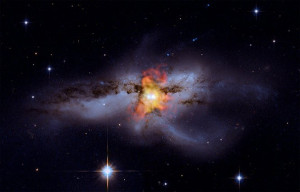Science Seen Physicist and Time One author Colin Gillespie helps you understand your world.
Things that go bump in the night: What happens when BIG black holes collide
Fifty years ago black holes were science fiction. Today they are observational physics and what we see is stranger than fiction. They send us messages about space and time.
Black holes form when the matter of a star more massive than our Sun collapses under its own gravity. Other black holes may have formed in the first tiny fraction of a second after the beginning of the universe when it was dense but there were no stars.
Last year’s breaking news was that we can directly detect gravitational waves two small black holes (with masses less than fifty Suns) give off when they collide. Last week brought news of another black-hole collision detected, the third we have detected—confirming my conclusion these events are common. This latest collision was some three billion light years away. It formed a new black hole with the mass of fifty Suns.
In less than a second this collision turned a mass like our Sun’s into pure gravitational energy. The shock shook the shape of space itself; its waves spread across the universe at the speed of light. Three billion years later two extremely sensitive instruments (collectively called LIGO) detected the waves as they passed Earth in a fraction of a second on January 4.
Big (aka supermassive) black holes are found at the hearts of galaxies. They are almost inconceivable objects. Each holds the mass of many millions or even billions of stars mashed into a space smaller than a subatomic particle—maybe (as some, like Stephen Hawking, say) into no space at all.
A big black hole is a 3D cosmic tornado of monstrous energies. It can casually rip a passing star apart, consume some of its matter and fling the rest away. Matter rarely falls straight in, so the black hole spins. Like a dancer whose rotation speeds up as she draws her arms in, a black hole (being so tiny) can spin at a fantastic rate. The staggering amount of mass in a big black hole may whip around a thousand or more times per second.
 Sometimes two galaxies collide. They then take a billion years or so to merge into a single galaxy. Their big black holes both seek the heart of the new galaxy. The white spots at the center of the image [left] mark two big black holes that may someday collide in galaxy NGC 6240—a bump in the night a billionfold more energetic than we have seen so far.
Sometimes two galaxies collide. They then take a billion years or so to merge into a single galaxy. Their big black holes both seek the heart of the new galaxy. The white spots at the center of the image [left] mark two big black holes that may someday collide in galaxy NGC 6240—a bump in the night a billionfold more energetic than we have seen so far.
Big-black-hole collisions are not common. Like surfers waiting for a forty-foot Waimea wave we may work with small ones for a while. But there’s another way astronomers can see if big-black-hole collisions do happen.
Depending on how the black holes’ spins are aligned, that blast of gravitational energy may mostly head off in one direction. In reaction, the newly merged black hole moves off the other way. When two big black holes collide the newly merged black hole may blast off at two percent the speed of light. This is the ultimate galactic leviathan. It exits its galaxy—leaving it in serious confusion—and heads off to roam, invisible unless it comes upon some chance encounter, the pathless ways of intergalactic space.
 An international group of astronomers report they have now found a clear case of this remarkable event, called a recoiling supermassive black hole. It holds 160 million Solar masses. Shown by the hot spot of chaos around it—the white dot in figure (b) above—it is far from the nucleus of the galaxy where it should be. And it is rocketing away at some 175 kilometers per second.
An international group of astronomers report they have now found a clear case of this remarkable event, called a recoiling supermassive black hole. It holds 160 million Solar masses. Shown by the hot spot of chaos around it—the white dot in figure (b) above—it is far from the nucleus of the galaxy where it should be. And it is rocketing away at some 175 kilometers per second.
Stay tuned for space-quaking news when—as is bound to happen—the wave front from one of these events blasts past Earth and shakes up LIGO with an even stranger fact.
Image credits:
NASA Marshall Space Flight Center; http://www.ctc.cam.ac.uk/news/150330_newsitem.php
Dong-Chang Kim et al; http://iopscience.iop.org/article/10.3847/1538-4357/aa6030/pdf

No comments yet.